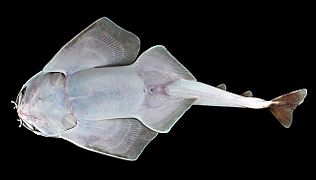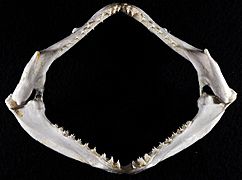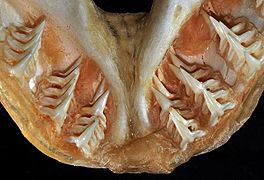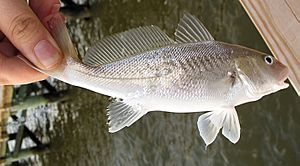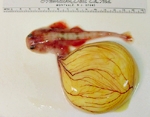Sand devil facts for kids
Quick facts for kids Sand devil |
|
|---|---|
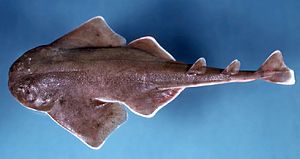 |
|
| Conservation status | |
| Scientific classification | |
| Genus: |
Squatina
|
| Species: |
d
|
 |
|
| Range of the sand devil | |
The sand devil or Atlantic angel shark (Squatina dumeril) is a special type of angelshark. It belongs to the Squatinidae family. You can find this shark in the northwestern Atlantic Ocean, especially off the eastern United States and in the northern Gulf of Mexico. It might also live in parts of the Caribbean Sea.
This shark likes to stay on the bottom of the ocean. In summer and fall, it lives in shallow waters close to shore. But in winter and spring, it moves to deeper waters further out. The sand devil looks a lot like a ray because its body is flat. It also has very large pectoral and pelvic fins. A cool feature is a line of big thorns running down the middle of its back. It's usually gray or brown with small dark spots. This shark can grow to be about 1.2 to 1.5 meters (4 to 5 feet) long.
Sand devils mostly eat small teleost fish and squid. They catch their food by hiding and then suddenly attacking. These sharks give birth to live young, which grow inside the mother and get food from a yolk sac. Female sand devils have babies every few years, giving birth to 4 to 25 pups in spring or early summer. Their pregnancy lasts about 12 months. Sand devils are not usually aggressive. However, they might try to bite if someone bothers them or catches them. People don't usually fish for them, but they can get caught by accident in fishing nets.
Contents
What's in a Name?
The sand devil was first described by a French naturalist named Charles Alexandre Lesueur in 1818. Before this, people thought it was the same as a European angel shark. Lesueur studied an adult male shark caught off the eastern United States. He named the species after André Marie Constant Duméril.
Scientists have studied the sand devil's DNA to learn about its family. They found that the sand devil is closely related to the Pacific angel shark. These two sharks are part of a larger group of angel sharks found in the Americas. Scientists believe these two species became separate around 6.1 million years ago. This happened when the Isthmus of Panama formed, which likely split their ancestors into two groups.
How to Spot a Sand Devil
The sand devil has a flat, somewhat narrow body. It has very large pectoral and pelvic fins. The skin on the sides of its head is smooth. Its big eyes are on top of its head, with clear breathing holes called spiracles behind them. Its nostrils have thin, pointed feelers called barbels.
The shark has a wide mouth at the front of its head. Inside, it has many rows of teeth, with gaps in the middle where there are no teeth. Each tooth has a wide base and a single sharp point with smooth edges. It also has five pairs of gill slits on the sides of its head for breathing.
Its pectoral fins are wide and angled, with narrow tips at the back. The front part of the pectoral fin is separate from the head. The sand devil has two dorsal fins, which are similar in size and shape. They are located far back on its body. It does not have an anal fin. The bottom part of its tail fin is bigger than the top part.
The shark's skin has small, rough scales called dermal denticles. A special feature is a line of larger thorns running along the middle of its back, from its neck to its tail. The top of the shark can be greenish-gray, bluish-gray, or reddish-brown. It has many small, darker spots and sometimes uneven patches. Its underside is always pale. This shark can grow to be about 1.3 to 1.5 meters (4.3 to 5 feet) long and weigh at least 16 kilograms (35 pounds).
Where Sand Devils Live
The sand devil lives in the northwestern Atlantic Ocean. You can find it from Massachusetts down to the Florida Keys, where it is quite common. It also lives in the northern Gulf of Mexico. There are also reports of it in Cuba, Jamaica, Nicaragua, and Venezuela, but these are not fully confirmed. It's hard to know exactly how far south they go because they can be confused with other similar angel sharks.
Because these sharks live in deep water and are not often caught for food, scientists don't have a lot of information about them. This means their exact living areas are sometimes unclear. This bottom-dwelling shark prefers sandy or muddy bottoms on the continental shelf and slope.
Off the eastern United States, sand devils move around depending on the season. In summer, they swim closer to shore, to depths of less than 35 meters (115 feet). Many can be found in water just a few meters deep. In the fall, they are still close to shore, but can be found down to 90 meters (300 feet) deep. In winter and spring, they move to the outer continental shelf, in waters deeper than 90 meters (300 feet). Some have been found as far as 140 kilometers (87 miles) from land and 1,290 meters (4,230 feet) deep.
Life and Habits
The sand devil is a predator that likes to hide. It spends a lot of time buried in the sand or mud at the bottom of the ocean. Its main food is fish that live near the bottom, like croakers, goatfishes, and butterfishes. However, they rarely eat very active fish like jacks, probably because those fish are too fast to catch. Squid are also a big part of their diet, especially for smaller sharks. Sometimes, they eat crabs, shrimp, mantis shrimp, skates, and bivalves.
Sand devils hunt both during the day and at night. They tend to choose prey that is about half to two-thirds the width of their mouth. This size helps them get the most energy from their food. They eat a wider variety of food in the fall and the least in winter. Smaller sharks also eat a more varied diet than larger ones. In the northern Gulf of Mexico, some of their favorite foods include Atlantic croaker, longspine porgy, spot croaker, Gulf butterfish, red goatfish, dwarf goatfish, and longfin inshore squid. The importance of each food changes with the seasons, depending on what is available. A tiny creature called a copepod can sometimes be a parasite on the sand devil.
Reproduction and Life Cycle
Like other angel sharks, the sand devil gives birth to live young. The baby sharks grow inside the mother and get food from a yolk sac. Female sand devils have one working ovary and two working uteruses. They usually mate in the spring. Male sand devils have special spines on their pectoral fins, which might help them hold onto the female during mating.
Females do not have babies every year; they reproduce at most once every two years, or maybe even less often. A female can give birth to anywhere from 4 to 25 pups. The number of babies does not seem to depend on the size of the mother. The pregnancy lasts about 12 months. The babies are born between February and June in waters about 20 to 30 meters (65 to 100 feet) deep. Newborn sand devils are about 25 to 30 centimeters (10 to 12 inches) long. Males become mature when they are about 93 centimeters (37 inches) long, and females mature when they are about 86 centimeters (34 inches) long. It's unusual for female sharks to mature at a smaller size than males.
Sand Devils and People
Sand devils are not usually aggressive towards people. However, if they are bothered or caught, they can bite and cause serious injuries. Their name "sand devil" comes from how they snap fiercely at fishery workers when caught. Even out of the water, they can lunge upwards to bite.
These sharks are sometimes caught by accident in large nets used by commercial fisheries that are trying to catch other types of fish. While you can eat sand devil meat, it is not often sold in markets. The International Union for Conservation of Nature (IUCN) currently lists the sand devil as a species of least concern. This means they are not currently at high risk of disappearing.
Images for kids
See also
 In Spanish: Angelote para niños
In Spanish: Angelote para niños




